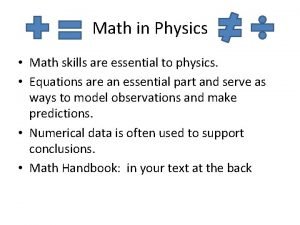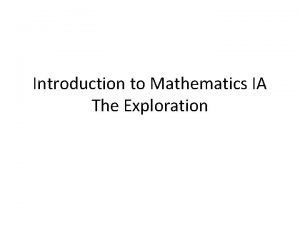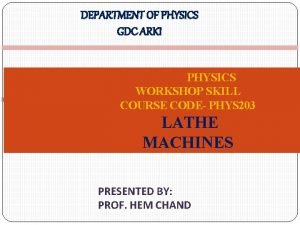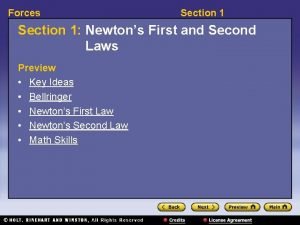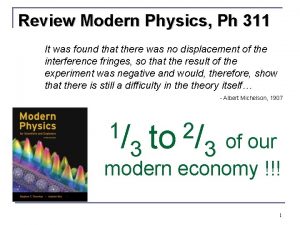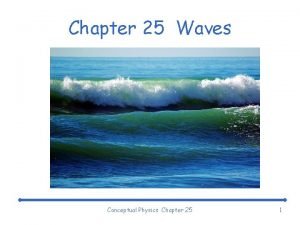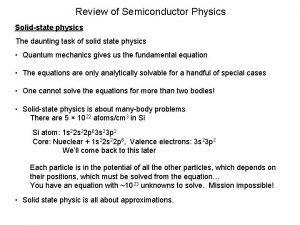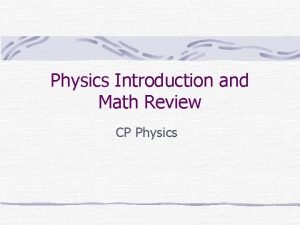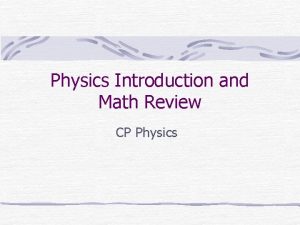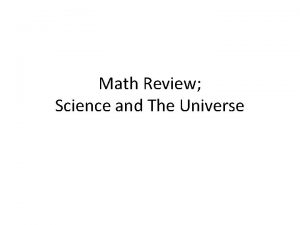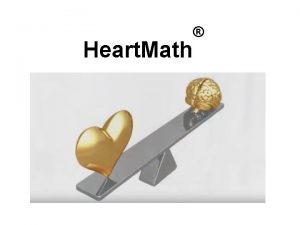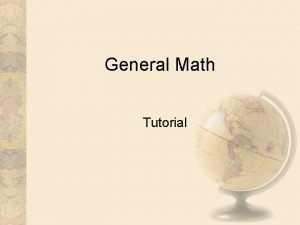Intro to Physics Math Skills Review Ms Denzmores



















- Slides: 19

Intro to Physics & Math Skills Review Ms. Denzmore’s Physics Class De. Bakey HSHP

What is physics? �Physics is the study of the physical world. �Consequently, there are many areas within physics…

My favorite area! Astrophysics: The physics of stars, galaxies, etc

Who needs math? �YOU NEED MATH! �In order to do well in physics, you’ll need to be proficient in algebra and some trigonometry and geometry �Let’s review some basic info

Scientific Notation �Why do we use scientific notation? �To make very big and/or very small numbers easier to handle �What is the average distance between the Sun and the Earth? � 93, 000 miles or 9. 3 x 107 miles �What is the average distance between the Sun and Pluto? � 3, 670, 052, 070 miles or 3. 67 x 109 miles

How to write a number in scientific notation. � 1. Put the decimal after the first non zero digit and drop the zeroes i. e. 93, 000 becomes 9. 3 � 2. Multiply the coefficient by 10 i. e. 9. 3 x 10 � 3. To find the exponent, count the number of places from the decimal to the end of the number i. e. 9. 3 x 107

Multiplying #s in Scientific Notation Rules for multiplication: � 1) Multiply the coefficients � 2) Add the exponents (base 10 remains !!!) �Examples: �(3 x 104)(2 x 105)= 6 x 109 �(5 x 103)(6 x 103)= 30 x 106 = 3. 0 x 107 �(3 x 10 -3)= 9 x 10 -6

Dividing #s in Scientific Notation �Rules for division � 1) Divide the coefficients � 2) Subtract the exponents (base 10 remains) �Examples: (6 x 105)/(2 x 102)= 3 x 103 (8 x 10 -6)/(4 x 10 -3)= 2 x 10 -3 (2 x 103)/(4 x 10 -8)= 0. 5 x 1011 = 5 x 1010

Significant Figures Rules for determining sig figs: � 1. All non-zero digits are significant � 2. Leading zeros in decimal numbers are not �significant � 3. Zeros between nonzero numbers are significant � 4. Trailing zeros in numbers without decimals are not significant. . . but if the number has a decimal, trailing zeros are significant.

How many sig figs? ? Example 1: 38. 15 cm Answer: 4 sig figs Example 4: 50. 8 mm Answer: 3 sig figs Example 2: 0. 008 mm Answer: 1 sig fig Example 5: 25, 000 years Answer: 2 sig figs Example 3: 0. 0156 oz Answer: 3 sig figs

Significant Rules When multiplying or dividing, the answer can only show as many significant digits as the measurement showing the least number of significant digits Example: 2. 05 x 3. 110 x 0. 0020 = 0. 12751 Answer: 0. 13

Significant Rules �When adding or subtracting, the answer can only show as many decimal places as the measurement having the fewest number of decimal places �Example: 2. 115 + 0. 0024200 + 000. 41 = 2. 52742 �Answer: 2. 53

Mars Climate Orbiter �Spacecraft launched in 1999 �NASA lost contact with it 9 months later �Investigation revealed that it burned up in the Martian atmostphere �Cost: $193 million �What happened?

It was the units!! �UNITS MATTER!! �If you don’t use the correct units, your answer will be wrong. �In physics, we use the metric system �Mass (kilograms: kg) �Time (seconds: s) �Length (meters: m)

Metric powers of ten

The ones you must memorize!

Examples �How many Hz are in 3250 GHz? �G is Giga (109) � 3250 GHz x 109 Hz 1 GHz 3. 25 x 1012 Hz �How many km are in 225 mm? � 225 mm x 10 -3 m x 1 km 1 mm 10 3 m Or � 225 mm x 1 km 1000 m 2. 25 x 10 -4 km

Be careful…some are tricky! �How many cm 2 are in 400 m 2? �When you have squared and cubic units, you must square or cube your conversion factors!! � 400 m 2 x ( 1 cm) 2 = 400 x 1 cm 2 = 4 x 106 cm 2 (10 -2 m) 2 10 -4

Another example �How many cm 3 are in 625 km 3 ?
 Si unit chart
Si unit chart Physics skills mathematics assessment answers
Physics skills mathematics assessment answers Math ia introduction example
Math ia introduction example Book review intro
Book review intro Ap government and politics unit 1 study guide
Ap government and politics unit 1 study guide Why does it happen
Why does it happen University physics with modern physics fifteenth edition
University physics with modern physics fifteenth edition Ib physics hl ia ideas
Ib physics hl ia ideas Physics workshop skills pdf
Physics workshop skills pdf How to improve intrapersonal skills
How to improve intrapersonal skills Soft skill
Soft skill Ontario skills passport
Ontario skills passport Section 1 forces (continued)
Section 1 forces (continued) Math game math hit the button
Math game math hit the button Ap physics 1 shm review
Ap physics 1 shm review Review of modern physics
Review of modern physics Random walks
Random walks Physics semester 1 review
Physics semester 1 review Chapter 25 concept review conceptual physics waves
Chapter 25 concept review conceptual physics waves Review of semiconductor physics
Review of semiconductor physics
